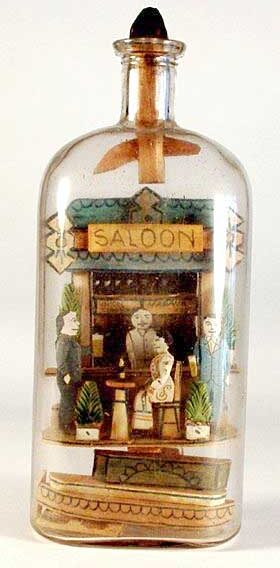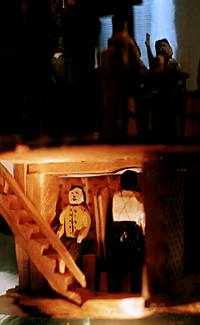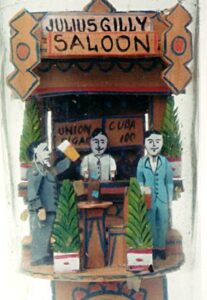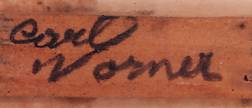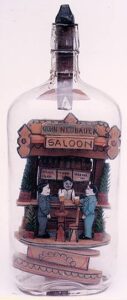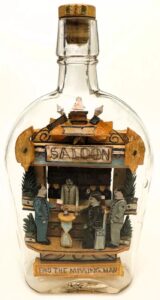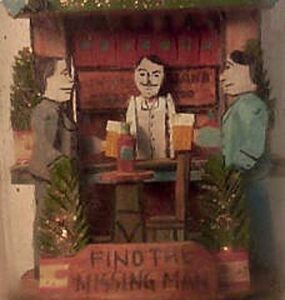Carl Worner was a bottle-making wonder, and from what we can gather from people whose fathers and grandfathers met him, he was a man with a fondness for a good cigar and a drink. We have found many places where he has been, but we have precious few facts about Carl, the man.
His art is very distinctive. His trademark bottle was a saloon scene, often with the saloonkeeper’s name over the bar, featuring a mustached bartender standing in front of rows of bottles and signs advertising Cuban cigars. In front of the bar, he put a table and chairs when space permitted. Two men usually stood at the bar, with glasses of beer raised in toast to each other. Sometimes the men were sitting at the table, and when the bottle was large enough, there were men standing and sitting. In one bottle, he carved a woman sitting at a table. Almost always he put a sign in front of the entire scene with the phrase “Find the Missing Man,” or “Find the 4 Man.” This was a challenge to find another figure, but he had hidden the last man under the floor of the bar, in a cubbyhole meant to be the toilet. Even when there was no sign to find the missing man, he would hide a man under the floor.
Besides saloon scenes, Worner carved shops and even some vignettes of family life around the dinner table. He made several crucifixion bottles (which seem to be early examples of his work), and he probably made a bottle containing a mantel clock. Only about a fourth of the known bottles are signed, and even fewer are dated.
There are very few hard facts about his life.
Presumably the earliest bottle we know of is signed along with “Hanau a Main,” a city in Germany he may have been born in. He made another religious scene in a pharmacy bottle from a Norwalk, Connecticut, drugstore that went out of business in 1896. He claimed to be from “New York, San Francisco and Honolulu” in 1901, and “New York and Chicago, Ill.” in another. He was a hobo in 1912 or 1913 when he came into the H. C. Meyers Saloon in Granite City, Illinois. He asked for an empty bottle and a cigar box and returned with the saloon bottle, which he presented to Mr. Meyers. And he showed Meyers how to present the “missing man” riddle so that the hidden cubbyhole was obscured by the holder’s hand. Whether or not he had always been a hobo is just conjecture. But he certainly moved around!
Worner made bottles for saloons and businesses in the St. Louis area, all around Chicago, north central Illinois, a town along the Erie Canal around Buffalo, NY, Havre-de-Grace MD, Reading and Wilkes-Barre PA, and Newark NJ. Another possibly came from Terre Haute, IN. Almost all of these places are near the coast, rivers, or canals. The earliest dated bottle is 1890 (not known from where), a bottle from the Chicago area is dated 1900, and the bottle from Maryland is dated 1901. The latest dated bottle is 1919, from Chicago. In an undated bottle, possibly from the 1920’s, he put his street address in Chicago, a center-city neighborhood. By finding the saloons and business establishments themselves, it is possible to get a range of dates on some of the undated bottles. For example, the “M. Rummel Saloon” bottle was probably made for Michael Rummel of Newark, NJ, whose saloon was listed in the city directories there from 1911 to 1916.
It can be assumed that Worner was born in a German-speaking country, probably in Hanau. In one of his saloon bottles hangs a poem written in German, which translates as “He who has not wine, women, beer and song is a poor man his whole life long.” He also used the German words for “beer” and “wine” on bar signs in that bottle. Other bottles were signed “Carl Wörner” clearly with an umlaut over the “o,” and one was additionally signed “Gemacht bei Hermann Domke, Bäkersgeselle,” which translates as “made at the establishment of Hermann Domke, journeyman baker.” That bottle is dated 1907. The 1890 bottle is signed “K. Worner,” Karl being a common German spelling, but the 1901 bottle says “Chas.” which is from English. It is doubtful that he ever became an American citizen.
He made a Meat Market scene for a butcher in Chicago; the family still has the bottle. The story they associate with this treasure is that Worner made it for them at the Columbian Exposition (World’s Fair) of 1893. The greatest number of his bottles have been found to come from Chicago and northern Illinois, including two which made reference to the coal industry. Perhaps he came to work in the coal mines, or perhaps he worked in shipping. Most of the places he made bottles were near water, either the ocean or rivers or canals. The Illinois coal country is connected to both the Great Lakes by river from Chicago, and to the Mississippi by canal to Molene. But the early Connecticut bottle may suggest that he came first to the east coast, worked around New York for a few years and went to Chicago to work building or servicing the Columbian Exposition. If he had a drinking problem, it could explain why he had only transient jobs and frequented so many saloons.
Because nobody who knew him is still living, it makes the research difficult. Family traditions are usually based on facts, and a number of these bottles are still in the possession of the families for whom they were made by Worner. He seems to have moved around too quickly to have been listed in the directories of the cities where he patronized the bars, but he may yet be found in the U.S. census. This artist of great talent is also a man of mystery, and every new bit of information on his art shows us more about his wandering life.
